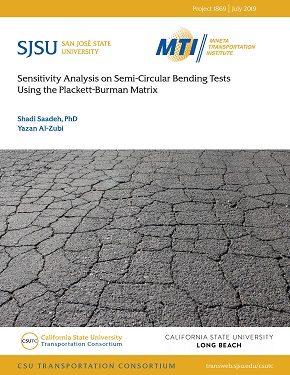- 408-924-7560
- mineta-institute@sjsu.edu
- Donate
Sensitivity Analysis on Semi-Circular Bending Tests Using the Plackett-Burman Matrix
Fatigue resistance of asphalt concrete (AC) is defined as the ability of the AC to resist repeated traffic loading without significant cracking or failure (Harvey et al. 1995). Fatigue cracking refers to primary distress in asphalt concrete due
to repetitive stress and strain caused by traffic loading. Several fatigue tests were developed to investigate the fatigue resistance of AC. Fatigue cracking is often associated with loads that are too heavy for a pavement structure. It is also associated with many repetitions of a given load (Roberts et al. 2009).
There have been multiple standards and tests to make sure that asphalt concrete mixture can withstand traffic load. The Semi-Circular Bending (SCB) test is a standardized test accredited by ASTM to compare the cracking resistance of asphalt mixtures prepared with different binder grades and aggregate types.
The SCB test has plenty of parameters that affect its results. In this study, some of these parameters are examined to ascertain the impact of each of these parameters on SCB test results. Examining all these parameters would be cumbersome using traditional statistical techniques, as they require a significant number of samples. The Plackett-Burman (PB) technique was used to perform a sensitivity analysis. The PB method relies on a limited number of scenarios to study the effects of multiple parameters. Seven parameters have been examined and include, notch location, notch depth low, intermediate and high, air voids, loading rate, and span length. Even with the usage of the PB technique there have been 16 scenarios that need to be tested for each of the three notch depths; whereby the process requires plenty of time and material. In order to turn around this problem, a Discrete Element Method (DEM) is used to develop a model that will substitute the need for an actual lab test. Results showed that the most positively impactful parameters on the SCB test results were intermediate notch depth and notch location, while the most negatively impactful parameters were loading rates and air voids.
SHADI SAADEH, PhD
Dr. Shadi Saadeh is a professor at California State University Long Beach. He holds a Bachelor’s Degree in Civil Engineering from the University of Jordan, a Master’s Degree in Civil Engineering from Washington State University, and a PhD in Civil Engineering from Texas A&M University.
YAZAN AL-ZUBI, BS
Yazan is a master’s student at California State University Long Beach. He holds a Bachelor’s Degree in Civil Engineering from Yarmouk University. He has an interest in construction management, pavement design, and development.
DAVID RENTERIA, MS
David Renteria is a Field Engineer at Terracon Consultants. He holds a Bachelor’s Degree in Civil Engineering from The University of Texas Pan American, and a Master’s Degree in Mechanical Engineering from the University of Texas Rio Grande Valley.
-
Contact Us
San José State University One Washington Square, San Jose, CA 95192 Phone: 408-924-7560 Email: mineta-institute@sjsu.edu






